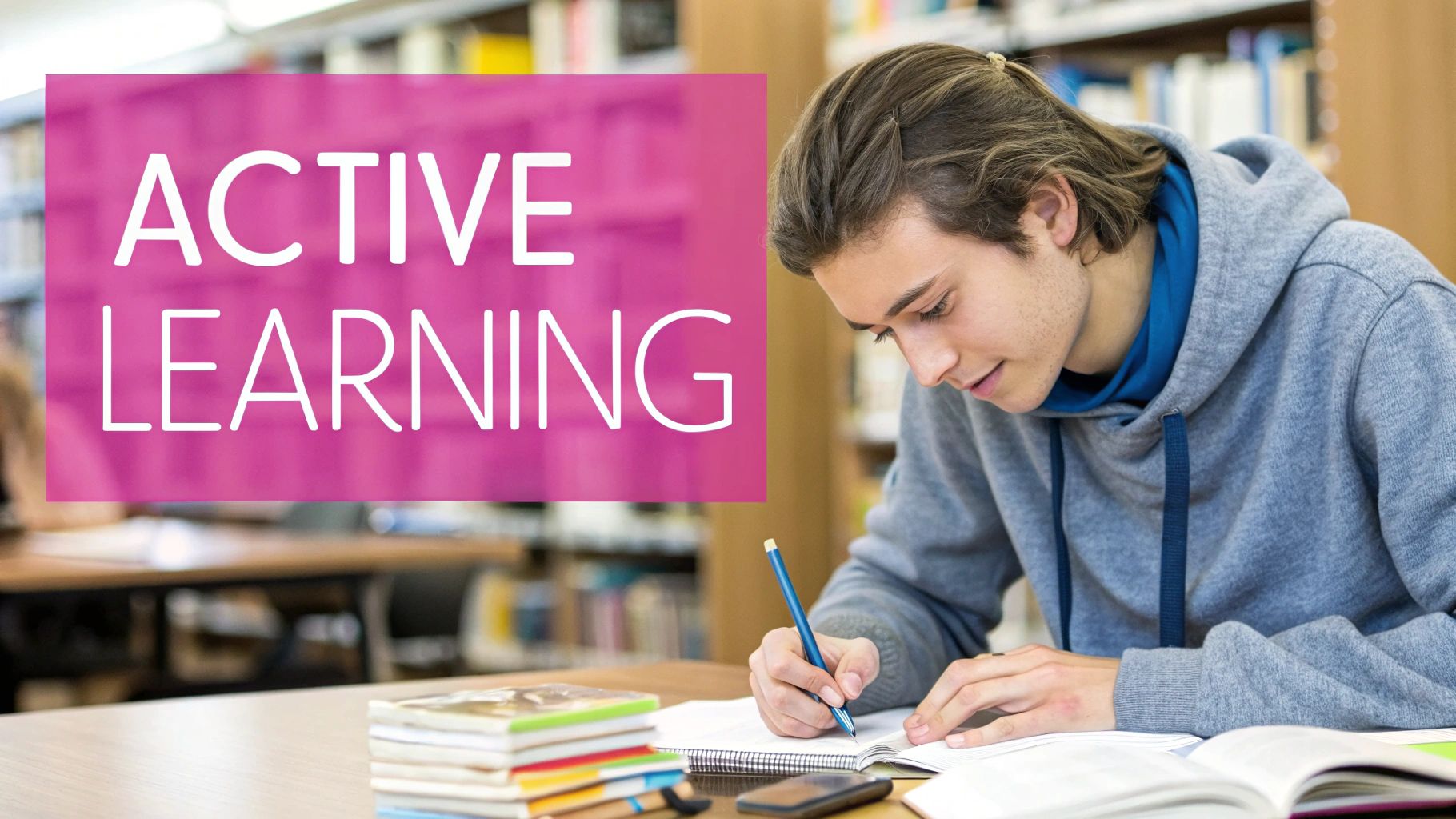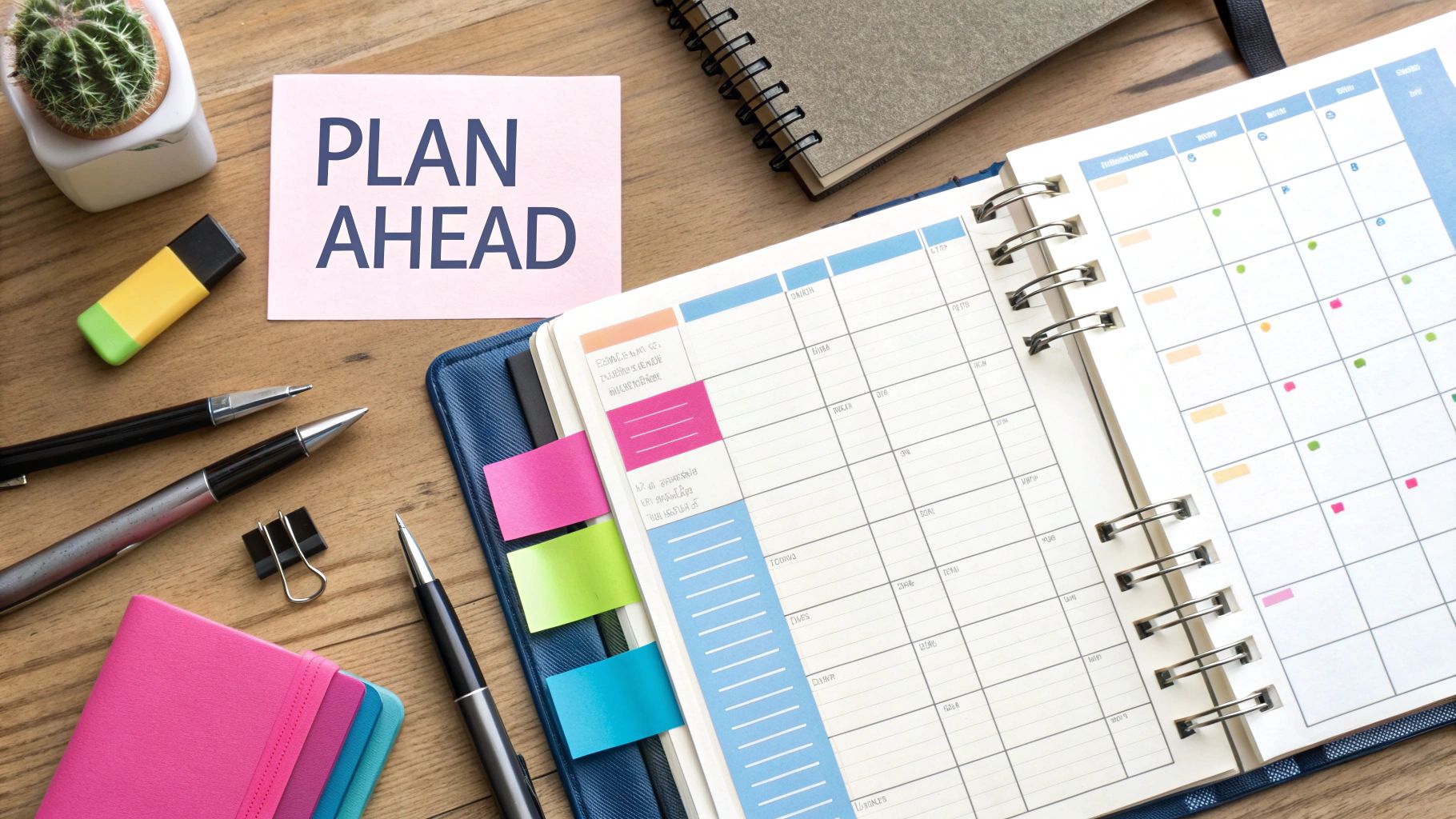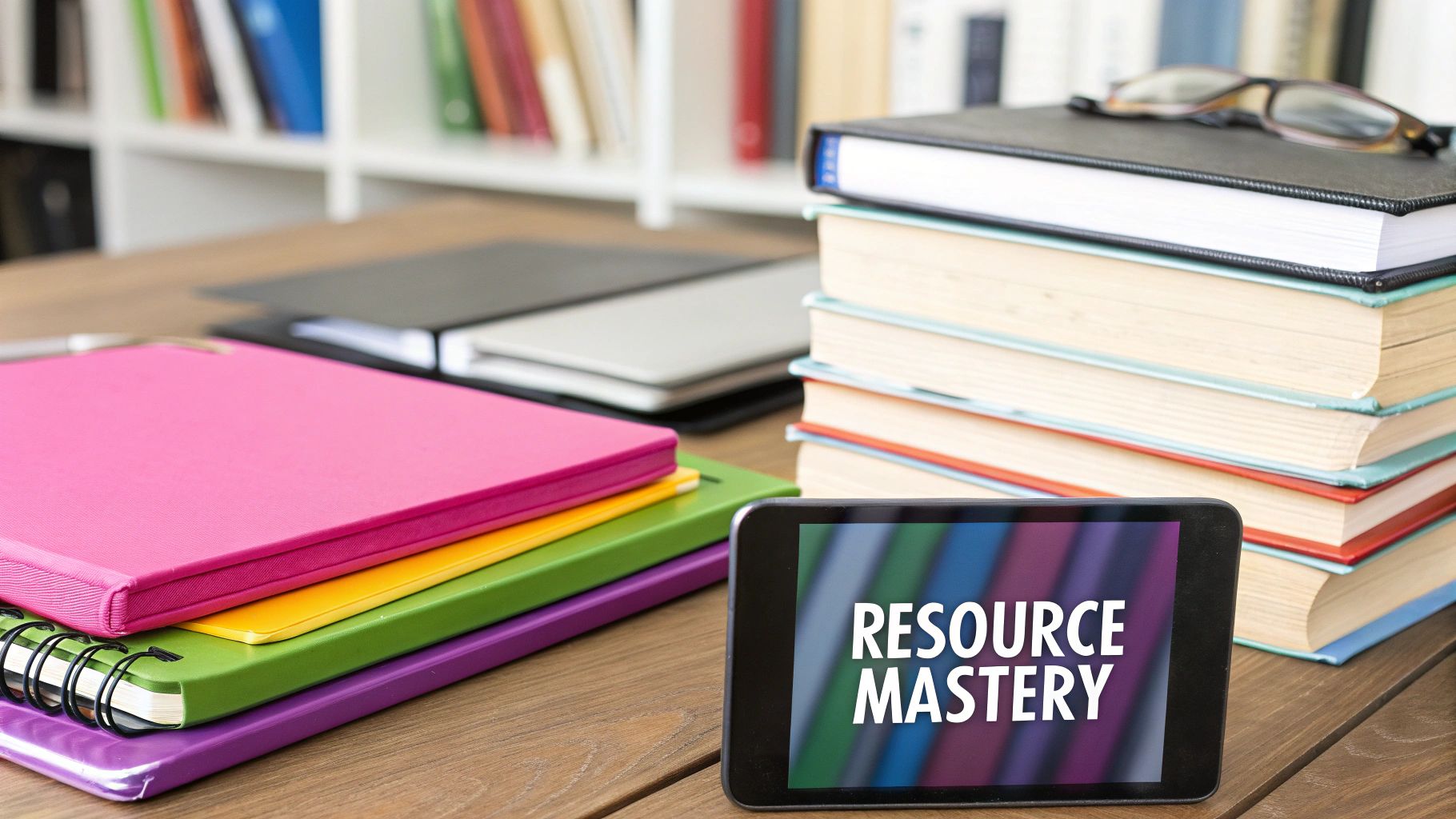
How to Study Effectively for Exams: The Ultimate Guide for Higher Grades
Setting Yourself Up for Study Success

When it comes to studying effectively, working smart beats working long hours. Just like building a house needs a strong foundation, successful studying requires thoughtful preparation and the right mindset. Let's explore how to create an environment and approach that sets you up for exam success.
Assessing Your Needs and Gathering Your Tools
Start by understanding exactly what you'll be tested on. Take time to carefully review your syllabus, course materials, and any available practice exams to define clear study goals. For instance, if your exam focuses mainly on applying concepts, you'll want to spend more time working through practice problems rather than memorizing definitions. Consider your personal learning preferences too – whether you learn best through visuals, listening, or hands-on practice can help guide your study methods.
Next, collect all your necessary study materials – textbooks, class notes, online resources, and study group connections. Choose tools that match your learning style and the exam format. Research from Stanford University found that students who carefully selected and planned their study resources improved their exam scores by an average of one-third of a letter grade. This shows how important it is to be strategic about your study materials.
Creating Your Personalized Study Plan
With a clear picture of the exam requirements and your learning style, develop a detailed study schedule. Break down the material into manageable sections rather than trying to tackle everything at once. This helps prevent overwhelm and allows you to track your progress more effectively.
Research consistently shows that spreading out study sessions over time leads to better long-term retention compared to cramming. Think of it like regular exercise – consistent, spaced-out practice builds stronger memories than an exhausting one-time session. Try reviewing material at increasing intervals – perhaps on days 1, 2, and 3, then after one week and two weeks.
Understanding Your Learning Process
Pay attention to how you learn best by monitoring which study methods work well for you and which don't. This self-awareness helps you adjust your approach for maximum effectiveness. For example, if you notice you struggle to remember certain types of information, try incorporating more active recall techniques like practice tests or teaching concepts to others.
Create a dedicated study space free from distractions – research shows that multitasking can reduce productivity by up to 40%. Having a consistent study environment helps train your brain to focus when you're in that space. By understanding your learning process and setting up the right conditions for success, you'll be well-prepared to achieve your exam goals through efficient, targeted studying.
The Power of Strategic Resource Planning
A dedicated study space and personalized plan are just starting points for success. Effective exam preparation requires careful selection and organization of study resources. Like a chef who carefully selects ingredients that work together harmoniously, students need to thoughtfully choose materials that will help them master the content. Let's explore how to build a strategic study plan that makes the most of your time and energy.

Identifying High-Impact Resources
Start by selecting materials that align with both your learning style and the exam format. For example, if you learn best through visuals and your exam focuses on concepts, prioritize mind maps and diagrams over dense textbooks. Quality matters too – stick to trusted sources like your professor's recommendations and peer-reviewed articles rather than random online summaries. This targeted approach ensures you spend time on resources that will actually improve your understanding.
Organizing for Active Learning
Once you've gathered your key materials, organize them to promote active engagement rather than passive review. Instead of simply re-reading chapters, transform the content into your own notes, flashcards, or video summaries. This process of rephrasing information in your own words strengthens your grasp of the material. Digital tools like Notescast can help by converting your notes into engaging video content that makes complex topics easier to understand.
Tailoring Your Approach to Specific Subjects
Different subjects require different study methods. History exams that test your recall of dates and events benefit from timelines and flashcards. Math exams focused on problem-solving need lots of practice problems and concept mastery. Just as you'd use different tools for different home repairs, adjust your study tactics based on the subject matter. This targeted approach leads to more efficient preparation.
Evaluating the Effectiveness of Popular Study Methods
Be willing to set aside common study techniques that don't work well for you, even if they're popular. Research shows that highlighting and re-reading are less effective than active recall methods like practice tests and explaining concepts in your own words. A study in Psychological Science found that students who carefully planned how they would use each resource saw major improvements in exam scores. The key is to actively engage with materials while regularly checking your progress. This helps you refine your approach over time for better results.
Mastering the Art of Spaced Practice
Want to ace your next exam? The key lies in understanding how your brain processes and retains information. Rather than cramming the night before, which only leads to short-term memorization, spaced practice (also called distributed practice) helps you build lasting knowledge by reviewing material at strategic intervals.
Why Spaced Practice Works
Think of your brain like a garden – each time you review information, you strengthen the neural pathways, similar to watering plants to help them grow. When you space out your study sessions, you force your brain to actively retrieve memories, making them stronger and more durable over time. Just as muscles get stronger through regular workouts rather than one intense session, your memory improves through consistent, spaced practice.
For example, when learning about statistical significance, instead of reviewing it once right before the exam, you could study it on days 1, 2, 7, and 14. This matches how we naturally learn through repeated exposure in real-world scenarios, helping concepts truly stick in your mind.
Implementing Spaced Practice Effectively
To make the most of spaced practice, follow these key steps:
- Break Down Complex Topics: Split your study material into manageable sections. Instead of trying to learn all of calculus at once, focus on derivatives one day and integrals another.
- Create a Review Schedule: Set specific intervals for reviewing each topic. A common approach is to review on days 1, 2, and 3, then after one week, and again after two weeks. This progressive spacing helps cement your learning.
- Use Active Recall Techniques: During review sessions, test yourself without looking at your notes. This reveals knowledge gaps and strengthens memory. Flashcards and practice quizzes work great for this.
- Be Flexible: While having a structured schedule helps, adapt based on what you need. If certain concepts are harder to grasp, review them more often. The goal is to work with your brain's natural learning process.
Building a Sustainable Routine
Making spaced practice a regular habit takes planning, but it's worth the effort. Here's how to integrate it into your study routine:
| Step | Action |
|---|---|
| 1 | Identify your peak study times. |
| 2 | Allocate specific slots for spaced practice. |
| 3 | Integrate active recall methods. |
| 4 | Regularly evaluate and adjust your schedule. |
By using spaced practice, you'll shift from passive reading to active learning that builds lasting knowledge. You'll understand material more deeply, remember it longer, and perform better on exams. Next, we'll explore additional active recall techniques to further boost your learning potential.
Active Recall: Your Secret Weapon for Better Grades

Spaced practice gives you the foundation for remembering information long-term, but active recall takes your studying to the next level. Rather than passively re-reading notes, active recall involves deliberately testing yourself to pull information from memory. Each time you work to remember something, you strengthen the neural pathways that help you access that knowledge during exams. The more you practice retrieving information, the easier it becomes to recall it when you need it most.
Why Active Recall Works
Think about learning a new language – simply reading a phrasebook might help you recognize words, but you won't be able to speak fluently without actually practicing conversations. Your brain needs active engagement to truly learn. When you force yourself to recall information before checking your notes, you're doing the mental equivalent of lifting weights – it's challenging but that's exactly what makes it effective. For example, try explaining photosynthesis from memory before reviewing your textbook. Research backs this up – a 2013 study found that students using active recall scored a full letter grade higher than those who just reviewed material passively.
Practical Active Recall Techniques
Adding active recall to your study routine is straightforward with these proven methods:
- The Flashcard Method: Create flashcards for key concepts and terms. Instead of immediately flipping cards over when stuck, first attempt to write or say the answer out loud. This extra step significantly improves retention.
- The Question-Creation Technique: Convert your notes and textbook headings into questions. For instance, change "Causes of the American Civil War" to "What were the main causes of the American Civil War?" This helps you think like a test writer and engage more deeply with the content.
- The Teach-Back Method: Explain topics as if teaching them to someone else, even if you're alone. Walking through concepts out loud reveals gaps in your understanding that need more work.
- Practice Tests: Take sample exams under test-like conditions. This not only strengthens recall but also builds familiarity with exam formats and time pressure.
Building a Systematic Review Process
For best results, weave active recall into a consistent review schedule that builds on your spaced practice routine. You might use flashcards in one session, then try teaching concepts in the next. This variety keeps studying engaging while exercising different aspects of memory. The combination of spacing out practice and actively recalling information creates a powerful learning system that improves retention and exam performance. Even short but regular active recall sessions yield major benefits over time. Now that we've covered active recall strategies, let's explore how to structure intensive study blocks for maximum impact.
Intensive Study Sessions That Actually Work

Getting the most out of your study time requires more than just putting in long hours – it's about studying smarter, not harder. The key is structuring your sessions to align with how your brain actually learns and retains information. Let's explore practical ways to design study blocks that help you maintain focus, avoid burnout, and achieve better results on exams.
Designing Focused Study Blocks
Your brain, like any muscle, performs best with intervals of focused work and rest. Research shows that 30-45 minute study blocks tend to be most effective for maintaining concentration. For instance, when studying for an exam, dedicate one 45-minute session to practicing sample questions on a single topic before moving on. This focused approach allows you to dive deep into the material without mental fatigue.
Take a 5-10 minute break between study blocks to help your brain process what you've learned. During these breaks, avoid mentally demanding activities like social media. Instead, get up and stretch, listen to some relaxing music, or take a short walk outside. These simple activities help clear your mind and prepare you for the next round of focused study.
Minimizing Distractions and Maximizing Productivity
One of the biggest barriers to effective studying is interruptions. Create a dedicated study space where you can work without distractions. Put your phone on silent, close unnecessary browser tabs, and let others know you're in study mode. Research consistently shows that trying to multitask actually reduces how much you learn and remember.
Consider using the Pomodoro Technique to maintain your focus: work for 25 minutes, then take a 5-minute break. After four work periods, take a longer 20-30 minute break. This simple method helps prevent mental fatigue while keeping you on track. You can use these timed blocks to tackle different aspects of your exam prep – from reviewing flashcards to working through practice problems.
Combining Learning Techniques and Measuring Progress
Mix up your study methods within each focused block to keep your brain engaged. Start with active recall using flashcards, move on to solving practice problems, then finish by explaining key concepts in your own words. This variety helps reinforce your learning while preventing boredom.
Track your progress regularly to identify areas that need more work. After each study session, take a few minutes to note what you've learned and what still feels unclear. Use practice tests to check your understanding and pinpoint topics that require extra attention. For example, if you consistently miss questions about a particular concept, plan extra practice time focused specifically on that area.
By thoughtfully structuring your study sessions around focused work periods, active learning methods, and regular progress checks, you can make your study time more productive. This balanced approach helps you learn more effectively while avoiding burnout, setting you up for success on exam day.
Building Your Personal Study Blueprint
After learning about techniques like spaced practice and active recall, let's put them into action with a personalized study plan. Just as you'd create a tailored workout routine based on your fitness goals, your study plan should match your exam objectives and preferred learning methods. This blueprint serves as a practical guide to help you prepare effectively while working with your natural study habits.
Crafting Your Personalized Study Schedule
Start by identifying when you study best. Whether you're most alert in the early morning or late at night, schedule your most challenging work during these peak hours. Break down your subjects into specific, focused chunks rather than broad categories. Instead of "Study Chemistry," plan sessions for topics like "Chemical Bonding" or "Acid-Base Reactions." This approach makes your goals clearer and progress easier to track.
Apply spaced practice by scheduling regular review sessions at increasing intervals. For instance, when studying World War II, you might review the material on day 1, day 3, then after one week, and again after two weeks. This systematic approach helps move information into your long-term memory.
Utilizing Effective Study Tools and Resources
Choose study tools that match how you learn best. Visual learners often benefit from charts, diagrams, and color-coding. If you learn by listening, try recording key concepts and playing them back during reviews. Those who learn by doing should focus on practice problems and hands-on activities.
Be selective with your study materials. Research in Psychological Science shows students who carefully chose their resources and planned their use improved their grades by up to one-third of a letter grade. Focus on quality materials that truly help you understand the content.
Adapting to Different Subjects and Maintaining Motivation
Different subjects often require different study approaches. History might call for timeline creation and flashcards, while math needs extensive problem-solving practice. Like a chef selecting the right knife for each task, pick study methods that fit each subject's specific needs.
Keep yourself motivated by breaking large goals into smaller milestones. Celebrate your progress along the way – perhaps with short breaks or small rewards after completing challenging sessions. This helps maintain momentum without burning out. Remember that consistent, steady effort usually beats intense cramming.
Troubleshooting Common Study Challenges
Every study plan faces obstacles. If procrastination is an issue, break tasks into smaller pieces with clear deadlines. For concentration problems, create a quiet study space away from distractions. Test different solutions and adjust your approach based on what works for you.
By developing a study plan that uses proven methods, fits your learning style, and includes strategies for common challenges, you can improve how you prepare for exams and reach your academic goals.
Boost your study efficiency by transforming your notes into engaging videos. Check out Notescast to learn more.
